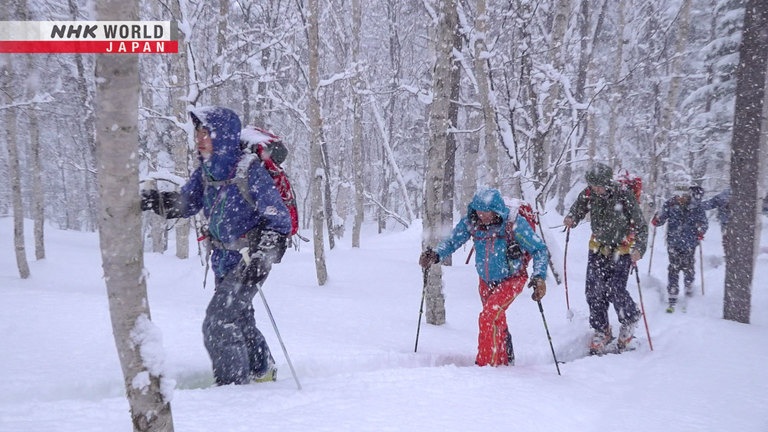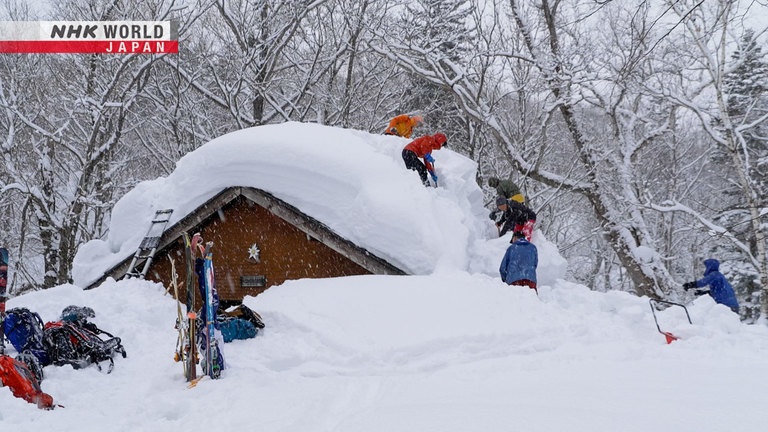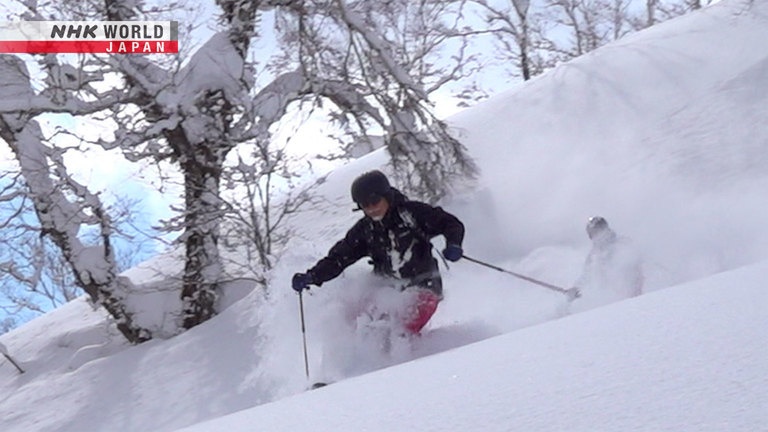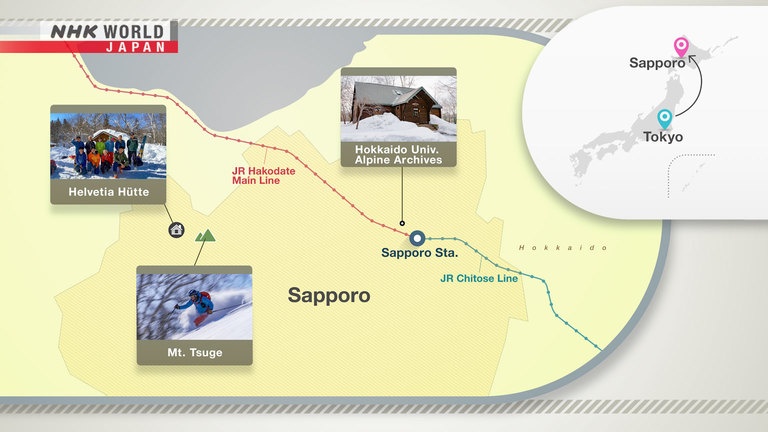Sapporo: Ski Mountaineering Tradition
In Hokkaido Prefecture, the sport of ski mountaineering has a long history. Making your way up into the mountains is possible when you have skis. Climbing through the deep snow requires skill, experience and thorough preparation. But the ascent is fun and heading down is even more so. In Japan, the first place where ski mountaineering began was the Academic Alpine Club of Hokkaido, which is part of Hokkaido University. The students here have been skiing for over 100 years. Cveto Podlogar is a licensed international mountain guide from Slovenia. On this episode of Journeys in Japan, Cveto heads out into the mountains with the Alpine Club for a training session, to get a taste of their ski mountaineering tradition.
Academic Alpine Club of Hokkaido, Hokkaido University

Students in Sapporo were first taught to ski by a German language teacher
from Switzerland in 1909. The university alpine club was founded in 1926 to continue the tradition of ski mountaineering.
Helvetia Hütte

On the outskirts of the city, the Academic Alpine Club has a mountain hut where students hold training camps. It was originally built by a Swiss university professor and to this day it's called Helvetia Hütte, from the Latin name for Switzerland.
Ski Mountaineering

The skis for ski mountaineering have dual attachments, so the heel can be left free for climbing and walking, as in Nordic skiing, but fixed for the descent, so you can ski down in the Alpine style.
Access

From Tokyo, flights take an hour and a half to New Chitose Airport, the gateway to Sapporo. Every day, there are dozens of flights.
Transcript
"Journeys in Japan"
The sport of ski mountaineering.
You just put on your skis and head up into the mountains.
Deep snow is no obstacle when you have skis.
It's fun climbing up, and even more fun heading down.
Skiing originally developed as a way for people
to get around in snowy conditions.
In Japan, the first place where ski mountaineering began
was the Academic Alpine Club of Hokkaido.
It's part of Hokkaido University.
The first step is to ski up into the mountains.
I think there's a snow bridge here.
Climbing through the deep snow requires skill,
experience and thorough preparation.
Cveto Podlogar is an international mountain guide from Slovenia.
On this edition of "Journeys in Japan,"
Cveto joins up with a university group
to get a taste of their ski mountaineering tradition.
Sapporo
Ski Mountaineering Tradition
For this journey, Cveto heads up to Sapporo.
It's the capital of Hokkaido, 830 kilometers north of Tokyo.
Sapporo, it's a fantastic town,
probably number one in the world
receiving over five meters of snowfall during the winter.
And here you can enjoy a lot of winter sports,
especially different styles of skiing.
I'm really looking forward, and I'm excited
about this epic journey to ski around Sapporo.
Sapporo has six ski resorts equipped with ski lifts.
It's easy for anyone to get out and enjoy the slopes.
Wow, look at this.
Sapporo City. Just 30 minutes from the hotel
and you have such a fantastic view.
Unbelievable.
It's going to be a nice day skiing
just in front of Sapporo City.
Let's ski.
Okay.
The usual form of skiing at resorts is Alpine skiing.
This style, which uses fixed heel bindings on the skis,
originated in the Alps in the early 20th century.
From Europe, it has spread all around the world.
But there are other styles of skiing
that you can experience in Sapporo.
At this park in the city center,
you can try out cross-country skiing,
which is a type of Nordic skiing.
The gear can be borrowed free of charge.
It's been a while since I've done this. I hope I can remember how to do it.
Cross-country skiing was originally a way for people
to get around in snowy conditions.
Unlike Alpine skiing, the skis have no heel bindings.
Cveto was formerly a competitive cross-country skier,
and was even on Slovenia's Olympic team.
Ichino san, would you like to try it?
It's fun.
No need to be scared.
It'll probably feel a bit strange at first.
Take strong strides.
If you don't push forward, you won't get anywhere.
This different style of skiing can feel strange at first.
But after a couple of hours, you should get the hang of it.
You've got the hang of it. You're quick.
Sapporo is a paradise for skiers,
and this is the place where it is said to have all started.
This building in Hokkaido University
commemorates the 70th anniversary of the founding of
the Academic Alpine Club of Hokkaido.
As well as a focal point for students,
it also houses materials on mountaineering,
skiing and other expeditions.
Is it true that Hokkaido was the place where skiing first started in Japan?
Skiing was first officially taught in Japan in 1911.
A military instructor from Austria introduced skiing to the Japanese army.
However, records show Hokkaido University students were already skiing two years before that.
At the time, there was a German language teacher from Switzerland at the university.
He brought over skis from his homeland and introduced his students to the sport.
The students immediately took to skiing, and in 1912 they formed a ski club.
Compared to studying German, I'm sure skiing must have been more fun.
From the start, skis were used for mountain climbing.
Thanks to their skis, the club members set many climbing records for the mountains in Hokkaido.
Later, club members who enjoyed skiing for fun split from those more interested in mountaineering.
That's how the Academic Alpine Club was formed.
On the outskirts of the city,
the Academic Alpine Club has a mountain hut
where students hold training camps.
It's called Helvetia Hütte.
How deep is it?
About 1.5 meters.
It's the third time this year we've cleared the roof.
Come on in.
Helvetia Hütte.
We take off our shoes, don't we?
This is Japan, after all.
So we'll be spending three days here...
This is a Swiss flag.
Helvetia is the Latin name for Switzerland.
The hut was built in 1927 by a Swiss professor, Arnold Gubler
who was teaching at Hokkaido University.
After he returned home, the hut was taken over by the university.
And for the past nearly 100 years,
it has been managed by the Academic Alpine Club.
It looks very similar. I have back in Slovenia,
our family, we have a mountain hut.
It's half the size of this one,
but it's very, very similar. So
it's a big nostalgic feeling being here in this hut.
What do you do here, when you're at this hut?
In winter, this is our hub for ski mountaineering.
In summer, we hike up streams or do other activities in the mountains.
We all use this hut, both the current students and also the senior members of the club.
So this hut is used all year by both current students and senior members?
Yes, we use it year-round.
Everyone loves this hut.
Do you have any disputes about when and who gets to use it?
That's not an issue. We all get on well when we're here.
Just like this time, we all get along regardless of the age difference.
Some of the students are building a chamber in the snow
where they intend to spend the night.
We're digging out a shelter in the snow. We do it from the top and from the bottom.
We dig two holes.
What are you doing?
We're preparing the blocks for the roof.
We cut them out with our shovels, and then pile them up on top.
The mountains in Hokkaido tend to have long approaches,
and trips can take several days.
So the climbers need to keep their packs as light as possible.
Often, they don't carry tents.
Instead, they spend the night in the snow chambers they make.
There are various styles and ways of making these artificial caves.
This one is simply a vertical hole in the snow,
with blocks of snow piled around the top to serve as a roof.
It's quick and easy to prepare.
From now on, we should stay away from this area.
It's finished.
- Can I look inside?
- Go ahead.
Nice, nice.
It's perfect!
It only takes them about 30 minutes to complete their igloo.
Sensei, welcome.
You've done a great job.
It was quick work. Have you done this many times?
Every year, we make about 10 of them.
Will you fill those holes from the outside?
Yes. If we don't do that the wind will blow in.
- It won't collapse, will it?
- No, it's strong.
How many people can it hold?
It can sleep three or four.
This is a skill that has been passed down through the years
by students in the Academic Alpine Club.
As evening falls, it's time to prepare supper.
This is how they put together a typical meal in the mountains.
It's a kind of porridge.
They mix in dried shiitake mushrooms,
wood ear fungus, garlic and other ingredients,
and simmer them with the rice until they're cooked.
You don't use any fresh ingredients?
They don't last, and they're too bulky to carry.
Do you always eat like this in the mountains?
- Yes.
- Always rice porridge.
- Even when you're staying a long time?
- We eat the same thing every day.
When you're hungry and tired, it always tastes good.
You don't add meat?
No meat. For protein, we add freeze-dried tofu.
At the end, they add freeze-dried tofu
and dried "wakame" seaweed, seasoning it with curry.
This recipe is a specialty of the Alpine Club.
Tanaka san, five stars.
It's delicious. Great!
If you always eat like this, then I want to join the club too.
Why did you all join the Alpine Club?
I liked the camaraderie and I wanted to go out climbing together.
I like to get out and enjoy the nature. That's why I wanted to join.
- Do you plan to continue climbing?
- Yes, even after I graduate.
"The driving blizzards have died down."
"The sunshine is warmer, and spring is coming."
"The noise of avalanches can no longer be heard."
"We can hear the music of the melting snow."
"Let's go now, my friends..."
"to the mountains of Hokkaido."
"Let's ski down these mountain slopes together."
On the second day of their training camp,
the team are planning to climb a nearby mountain... on their skis.
What is the plan for today?
We will hike alongside the stream... and then head along the right side of this ridge.
We'll keep on climbing... to the top of Mt. Tsuge.
For the ascent, they attach anti-slip climbing skins
to the bottom of their skis.
How do you put on your skins?
I think skins like this are only used in Hokkaido now.
Modern skins are stuck on using adhesives.
But the traditional type used in the old days
are attached with string or bands.
Unlike the skins that stick with adhesive, this type can be used again and again.
On long mountain trips they're very useful.
Are you going to wear those shoes for climbing?
Yes.
So the priority is on hiking.
The young people here have the vintage gear.
Did you use them when you were a student?
Yes, I did. When I was young, everyone used them.
I started ski mountaineering over 30 years ago, and I've always used the adhesive seals.
For ski mountaineering, the skis have dual attachments,
so the heel is left free for climbing and walking as in Nordic skiing,
but fixed for the descent as in Alpine skiing.
Let's check our beacons. Gather around.
I'll go and check our route.
There are no bridges around here.
To get across this stream, they will have to locate a snow bridge that is safe.
Did you get across?
Take care.
The plan is to climb up this valley and then follow the ridge.
The stream on the right side seems quite deep.
Is that the stream ahead of us?
We start climbing the ridge here.
Unlike the most popular mountains that attract numerous climbers,
there are no fixed routes up these snow-covered mountains.
Being able to read a map is absolutely essential.
This seems to be where the ridges join.
Do we climb the ridge in front of us?
Yes.
Four hours have passed since they set out.
We've made it!
The summit of Mt. Tsuge.
I'm looking forward to skiing back down.
Now they are at the summit,
they can take off the climbing skins and get ready for the descent.
But before they set off, they check the snow to see if it's safe to ski down.
One... two...
It's distorted a bit.
There are avalanche layers at about 30 cm and 70 cm below the surface.
Seven...
eight...
nine...
ten.
But the deviation is larger when the snow is unstable.
What's your opinion?
You hit it hard, but it only broke up a bit. So I think it will be okay.
Today the snow is safe.
As they check the snow, the sun starts to break through.
With visibility improved, this is their chance.
Let's go!
The snow is pure white and unblemished.
This is one of the pleasures of backcountry skiing.
Go for it!
Koizumi san, you're a superb skier.
Not at all.
- Are you enjoying it?
- Very much!
The snow is still good.
It took four hours to reach the top,
but less than an hour to ski back down.
Well done everyone!
Tanaka! Great work as our leader!
Recently, the backcountry skiing is getting really popular,
but accidents are increasing.
And "backcountry" means just simply "winter mountains."
It doesn't matter really how good you are at skiing on the piste, on the groomed slopes.
But when you step out, you know,
on the mountains, you're on your own and you really need
to have knowledge how to do it safely
and to enjoy these kinds of things.
This time I joined the Academic Alpine Club of Hokkaido
during their learning process, how to do backcountry the safety way,
and enjoyed skiing on this beautiful mountain.
So I would really strongly recommend
to join one of these groups and learn the process for safety,
and the really, really wonderful mountains of Hokkaido.
From Tokyo, flights take an hour and a half
to New Chitose Airport, the gateway to Sapporo.
Every day, there are dozens of flights.